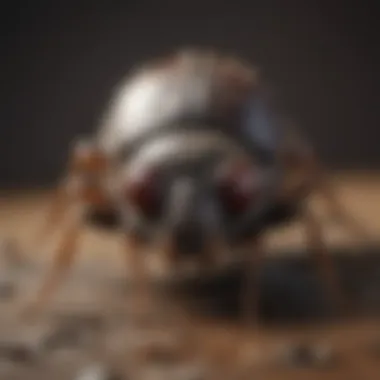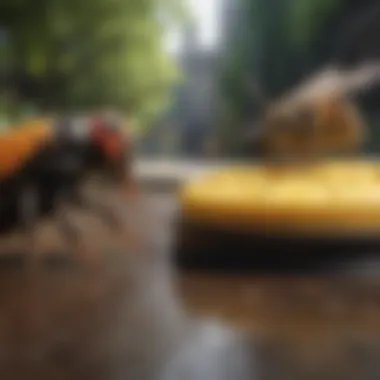Understanding Motherlode Pest Control Strategies


Intro
In today’s world, pest control is more than just a nuisance; it has evolved into a complex field that intertwines sustainability with effective management practices. The concept of Motherlode Pest Control encapsulates this evolution, offering a multi-faceted approach to dealing with pest problems. Understanding the intricacies of pest behaviors and effective management strategies is vital for homeowners and individuals striving towards sustainable living. This article will explore the various aspects of pest control, including the significance of identifying pests, prevention methods, and eco-friendly solutions that align with modern values.
By delving into methodologies and discussing common pests, this resource aims to equip readers with insightful knowledge. The forthcoming sections detail the anatomy of pest issues, highlight preventative measures for homes and gardens, and present sustainable practices. This comprehensive narrative empowers individuals to manage pests in an informed manner.
Understanding Pests
Definition of Pests
Pests are organisms that damage crops, spread diseases, or negatively affect human comfort and health. These can include insects, rodents, and even certain plants. The presence of pests can disrupt daily life and even threaten food supply. Understanding what qualifies as a pest is crucial for effective management and control.
Importance of Pest Identification
Proper identification of pests is critical for several reasons:
- Tailored Treatment: Each pest species may require a different management strategy, so identifying the pest allows for a targeted response.
- Preventing Resistance: Misidentification can lead to the wrong treatment being applied, which may contribute to pest resistance over time.
- Understanding Behaviors: Knowledge of a pest's life cycle and behavior aids in effective prevention and control measures.
Identifying which pests are present in or around your home will enable better planning and resource allocation.
Prevention Techniques
Home and Garden Preventative Measures
Effective pest control starts with prevention. Implementing basic measures can greatly reduce the likelihood of pests invading your home. Some strategies include:
- Sealing Entry Points: Ensure cracks, gaps, and openings in walls and foundations are sealed to prevent pests from entering.
- Proper Garbage Disposal: Regularly clean and seal your garbage can. Pests are often attracted to food waste.
- Maintaining Cleanliness: Keeping your living spaces clean reduces shelter for pests. Regular vacuuming and cleaning eliminate food sources and nesting sites.
Seasonal Prevention Tips
Pest activity can vary with the seasons, so adjusting your prevention strategies accordingly is wise. For example:
- Spring: Repair screens, inspect for cracks, and treat for emerging pests like ants and termites.
- Summer: Regularly check outdoor plants for infestations; pests thrive in warmer months.
- Fall and Winter: Ensure that all entry points are secure before pests seek shelter indoors.
Eco-Friendly Pest Control Solutions
Overview of Sustainable Practices
Motherlode Pest Control emphasizes sustainable practices by integrating nature-friendly solutions. This approach not only addresses pest problems but also protects the environment and human health. Sustainable methods may involve:
- Integrated Pest Management (IPM): This strategy combines various management approaches to control pests effectively without causing harm to the environment.
- Biological Controls: Utilizing natural predators or parasites to keep pest populations in check.
Natural Remedies and Their Effectiveness
Various natural remedies have shown effectiveness against common pests:
- Diatomaceous Earth: An abrasive powder that can control pests like cockroaches and ants without harmful chemicals.
- Essential Oils: Oils such as peppermint and lavender can deter insects and are safe to use around homes.
- Soap Sprays: Soapy water can kill soft-bodied insects like aphids when applied directly.
Each of these methods can be adapted for different pest types and situations, providing sustainable options for homeowners.
Defining Motherlode Pest Control
Origins of the Term
The term "Motherlode" signifies a rich source of something valuable. In this context, it refers to a wealth of knowledge and resources available for pest control. The concept has evolved from traditional pest management to a more sustainable and holistic approach. This shift is crucial as it aligns with growing environmental concerns.


Historically, pest control relied heavily on chemical methods that often posed risks to health and ecosystems. However, as awareness of these hazards increased, so did the search for alternative solutions. Motherlode Pest Control represents this evolution, where the impetus is not only to eliminate pests but to do so in a manner that respects the environment.
Core Principles
At the heart of Motherlode Pest Control are several core principles that guide its practice. These include:
- Holistic Approach: This method considers the entire ecosystem, focusing on balance rather than elimination.
- Sustainability: Emphasizing long-term solutions that protect the environment and reduce reliance on harmful chemicals.
- Education and Awareness: Providing information about pest behaviors and life cycles is key to effective management. Knowledge empowers homeowners to take proactive measures.
- Integrated Strategies: Combining various techniques to assess and manage pest populations effectively, rather than relying on a single method.
"Understanding pest behaviors can drastically improve management strategies, leading to a healthier home environment."
The significance of defining Motherlode Pest Control extends beyond mere terminology. It involves recognizing the interplay of ecological factors and the importance of informed decision-making. As homeowners adopt these principles, they contribute to broader efforts in sustainable living and environmental conservation. This understanding will serve as a stepping stone for subsequent discussions in the article, ensuring readers appreciate the significance of pest management.
Understanding the Pest Landscape
Understanding the pest landscape is essential for developing effective pest control strategies. Recognizing the type of pests that typically invade homes and comprehending their behaviors can significantly enhance pest management. By gaining an awareness of not just what pests are common, but also how they live, reproduce, and interact with their environment, individuals can implement targeted solutions. This approach minimizes the use of harmful chemicals while reducing the chances of future infestations.
In the context of Motherlode Pest Control, addressing the pest landscape informs not only the prevention techniques employed but also the methods of eradication appropriate for different scenarios. Thus, grasping this concept can lead to efficient, eco-friendly pest management.
Common Household Pests
Households often face numerous pest challenges. Common pests include ants, cockroaches, rodents, termites, and bed bugs. These pests vary significantly in their behaviors, habitats, and the specific threats they pose to homes. Understanding these nuisances allows homeowners to identify early signs of an infestation and take appropriate actions.
- Ants: Ants often form colonies outside before entering homes to search for food. They can be particularly problematic in kitchens.
- Cockroaches: Cockroaches thrive in warm and humid environments. They can carry diseases and contaminate food.
- Rodents: Mice and rats can squeeze through tiny gaps to enter homes, looking for nesting sites and food. Their droppings can present health risks.
- Termites: Termites feed on wood, leading to significant structural damage if left unchecked.
- Bed Bugs: Bed bugs are elusive and can exploit nearly any environment. They are typically found in bedding and furniture.
Understanding the specific habits and preferred environments of these pests is crucial for effective control. Strategies to combat these pests can range from proper sanitation to targeted treatments appropriate to the species.
Life Cycles and Behaviors
The life cycles and behaviors of pests play a vital role in their management. Each pest species has a distinct life cycle that often includes multiple stages, such as egg, larva, nymph, and adult.
- Reproduction: Many pests reproduce rapidly. For example, a single female cockroach can produce up to 400 offspring in her lifetime, leading to a swift escalation in numbers.
- Habitat Preferences: Knowing where pests prefer to dwell can aid in prevention. For instance, mice tend to nest in basements and attics, while ants favor outdoor spaces with access to food and water.
- Feeding Behaviors: Understanding what pests eat can guide effective baiting strategies. For instance, putting out food traps can attract and kill specific pests, providing immediate results.
Gaining insight into these behavioral patterns not only assists in immediate pest control efforts but also informs long-term strategies for prevention. By recognizing potential vulnerabilities and environmental attractants, homeowners can create less inviting spaces for pests.
"Understanding the behaviors and life cycles of pests is crucial in preventing infestations and maintaining a pest-free environment."
This comprehensive grasp of pests and their ecosystems sets the foundation for informed pest management and sustainable living—core tenets of Motherlode Pest Control.
Integrated Pest Management Strategies
Integrated Pest Management, or IPM, is a cornerstone of effective pest control. This approach combines various management strategies and practices to reduce pest populations in an environmentally responsible manner. By focusing on prevention, monitoring, and assessment, IPM seeks to minimize the use of hazardous chemicals, which can have unintended consequences on both human health and the environment. In this section, we will explore the specific elements of IPM, emphasizing its benefits and considerations.
Prevention Techniques
Prevention is the first line of defense in integrated pest management. By implementing proactive measures, homeowners can significantly diminish the likelihood of pest infestations. Here are key prevention techniques:
- Seal Entry Points: Inspect your home for cracks and gaps. Use caulk or weather stripping to close possible entry routes.
- Maintain Cleanliness: Regularly clean food spills and crumbs. Stored food should be in airtight containers to thwart pests.
- Manage Landscaping: Trim vegetation that is too close to the building. This limits hiding spots for pests and reduces moisture retention.
- Monitor Water Sources: Fix leaky pipes and eliminate any standing water, as these can attract pests.
By adopting these strategies, you create an environment that is less inviting to pests, thereby reducing the need for more extensive pest control efforts later.
Monitoring and Assessment
Monitoring and assessment form the second crucial stage of the IPM process. This phase involves observing pest populations and understanding their behaviors to determine the appropriate control measures. Effective monitoring allows homeowners to take timely action before small infestations escalate. Here’s how to approach it:
- Regular Inspections: Carry out routine checks in and around your home. Be vigilant about common pest signs, such as droppings or nests.
- Record Observations: Keep a log of pest activity. Note the types of pests, locations, and times of year when infestations occur.
- Assess Threshold Levels: Identify acceptable pest levels. Some pests are harmless in small numbers. Knowing the threshold helps decide when to act.
- Use Traps: Set up traps in strategic locations. They are helpful to capture pests and provide tangible data on pest activity.


"Effective monitoring and assessment can save both time and money in pest management efforts. An informed approach ensures that appropriate measures are taken promptly."
Engaging in continuous monitoring simplifies the process of pest management. When integrated with prevention techniques, it enhances the overall effectiveness of control strategies, creating a sustainable approach to pest management in your home.
Through understanding and implementing these integrated pest management strategies, homeowners can cultivate a healthier living space. This minimizes the ecological footprint associated with traditional pest control methods, affirming the commitment to sustainability.
Eco-Friendly Pest Control Solutions
Eco-friendly pest control solutions play a significant role in modern pest management strategies. Given the growing concerns over the environmental impact of traditional pesticides, homeowners and pest control professionals alike are turning to sustainable alternatives. Eco-friendly solutions can reduce potential harm to non-target organisms while ensuring effective pest management. This approach is vital for preserving ecosystems, protecting human health, and promoting sustainable living practices.
Additionally, embracing eco-friendly methods can lead to long-term pest control solutions. Unlike synthetic chemicals, which may provide short-term relief, natural remedies often improve the overall health of the home environment. Recognizing this, we can explore specific eco-friendly options, their benefits, and important regulatory considerations in the following subsections.
Natural Remedies
Natural remedies for pest control utilize ingredients derived from natural sources. Examples include diatomaceous earth, essential oils, and vinegar. These substances provide various advantages:
- Safety: They are generally less harmful to pets, children, and beneficial insects.
- Accessibility: Often, these materials can be found in homes or local grocery stores.
- Environmentally Friendly: Natural remedies reduce chemical runoff and pollution.
- Cost-Effective: Many natural solutions involve minimal expenses compared to commercial products.
Using natural remedies requires an understanding of pest behavior and identification. For instance, peppermint oil may repel ants, while traps using sugar water can effectively catch fruit flies.
Chemical Alternatives
Chemical alternatives refer to eco-friendly pesticides that are designed to be less harmful to the environment compared to traditional pesticides. These may include biopesticides derived from natural living organisms or substances. Here are key considerations about chemical alternatives:
- Effectiveness: Many modern biopesticides maintain high levels of effectiveness against common pests.
- Regulation: These chemicals are subject to rigorous testing and approval processes to ensure safety for humans and the environment.
- Multi-Target Capability: Some alternative chemicals can target a range of pest species without harming beneficial insects.
Adopting chemical alternatives aligns with a commitment to sustainable practices and offers efficient solutions for pest management while limiting risk to non-target organisms.
Regulatory Considerations
When implementing eco-friendly pest control, it is crucial to consider regulatory frameworks governing pesticide use. The following points outline key aspects:
- Approval Process: Eco-friendly pesticides must often go through a testing and approval process by environmental protection agencies.
- Labeling Requirements: Clear labeling is essential to inform users about application, safety, and handling.
- Usage Guidelines: Adherence to proper usage guidelines ensures effectiveness and minimizes risks.
Staying informed about regulations helps homeowners and pest managers make responsible decisions regarding the use of eco-friendly alternatives. Following guidelines also encourages a broader adoption of sustainable practices in pest control.
"Embracing eco-friendly pest control not only protects our homes but our planet as well."
By prioritizing eco-friendly pest control solutions, individuals can actively contribute to a healthier environment while effectively managing pest issues.
Technological Advances in Pest Control
The landscape of pest control is evolving rapidly, driven by innovations in technology. These technological advances are crucial in Motherlode Pest Control strategies, allowing for more effective and sustainable approaches. The integration of smart technologies, along with data-driven decision-making, provides a comprehensive understanding of pest-related issues and enhances the overall management processes. By utilizing cutting-edge tools and methods, homeowners are better equipped to tackle pest challenges in an environmentally responsible manner.
Smart Technology Applications
Smart technology is making significant inroads in pest control. Devices such as smart traps, sensors, and monitoring systems have transformed how pest issues are detected and managed.
- Remote Monitoring: Users can access real-time data about pest activity through mobile applications. This means instant access to information can lead to timely interventions.
- Automated Responses: Some systems can release attractants or repellents autonomously based on detected pest presence. This reduces the need for manual checks and interventions.
- Data Analytics: These devices collect data on pest behavior over time, allowing users to understand patterns and make informed decisions on pest control methods.
These smart applications not only assist in managing current pest issues but also help predict potential infestations. The forward-thinking approach of implementing technology reduces reliance on harmful chemicals, promoting a more sustainable future in pest management.
Data-Driven Decision Making
Data plays a pivotal role in modern pest control strategies. Analytics and data collection provide insights that influence pest management decisions.


- Trend Analysis: By studying historical data and current trends, homeowners and professionals can identify pest hotspots and seasonal patterns, enabling proactive measures.
- Resource Allocation: Gathering data ensures that resources are allocated effectively, minimizing waste and ensuring targeted pest control efforts.
- Evaluation and Improvement: Continuous monitoring allows for assessing the effectiveness of pest control strategies. Adjustments can be made based on actual performance metrics rather than assumptions.
Through data-driven decision making, pest management becomes more precise. Leveraging such information contributes to ecological balance and can lead to long-term success in pest control.
"Harnessing technology in pest control provides a new dimension that enhances efficiency and sustainability. A proactive approach not only protects our homes but also the environment."
Challenges in Pest Management
Pest management faces numerous challenges that can significantly hinder effective implementation. Understanding these challenges is essential for creating robust strategies in the Motherlode Pest Control framework. Factors such as pest resistance, environmental impacts, and socio-economic considerations all play a vital role. Addressing these elements can help improve the efficacy of pest control initiatives while promoting sustainable practices.
Resistance Issues
One of the most significant hurdles in pest management is the issue of resistance. Many pests develop resistance to commonly used pesticides over time. This phenomenon occurs when pests survive treatments due to genetic variability, leading to an increase in the resistant population. The over-reliance on specific chemical solutions accelerates this issue.
"Understanding resistance mechanisms is crucial for developing effective pest management strategies."
As pests adapt, traditional methods become less effective, forcing homeowners to resort to stronger chemicals, which can further negatively impact the environment. It is important to rotate different classes of pesticides and integrate non-chemical methods, like traps and biological controls, to combat resistance development. Such strategies not only enhance their efficacy but also help in delaying the emergence of resistance.
Environmental Impact
The environmental ramifications of pest control practices are another critical concern. Chemical pesticides, while effective, often have far-reaching consequences. They can contaminate soil, water, and even the air, posing risks to non-target species, including beneficial insects, birds, and other wildlife.
Homeowners must consider these impacts when choosing pest management strategies. Opting for eco-friendly solutions can minimize harm to the ecosystem. For instance, employing integrated pest management approaches can preserve biodiversity while managing pest issues effectively. Utilizing natural predators or organic repellents reduces reliance on chemical agents and helps in maintaining healthier environments for both humans and wildlife.
Future Directions in Pest Control
The future of pest control stands at a crucial crossroads. As we explore the implications of Motherlode Pest Control, we recognize the importance of integrating sustainable practices into everyday pest management. The landscape of pest control is changing. This shift arises from an urgent need for solutions that protect not only our homes but also the environment. The trends we observe today will shape our approach to pest management, emphasizing long-term benefits rather than short-lived fixes.
Trends in Sustainability
Sustainability trends in pest control illustrate a paradigm shift rooted in ecological practices. Homeowners are increasingly aware of the impact of chemical treatments on both health and the environment. Trends such as using less toxic pesticides, promoting biodiversity, and embracing integrated pest management practices are gaining momentum.
- Reduction of Chemical Use: This trend focuses on minimizing chemical pesticides in favor of organic options. Homeowners are adopting natural repellents and traps that do not pose risks to family or pets.
- Biological Control: Beneficial insects, like ladybugs or parasitic wasps, are being used more frequently to manage pest populations effectively. This method aligns with the principles of nature, providing a balanced ecosystem approach.
- Smart Landscaping: Responsible gardening practices, such as selecting pest-resistant plants or incorporating companion planting, make gardens less hospitable to unwanted pests. This proactive strategy is not just efficient but also enhances the beauty of landscapes.
These sustainable practices, therefore, not only help in controlling pests but also contribute to the health of the environment. This trend signifies a deeper understanding of ecosystems and encourages the decision-making process that centers on responsibility and resource conservation.
Collaborative Approaches to Pest Management
Collaboration plays a fundamental role in modern pest control strategies. It recognizes that addressing pest issues often requires a community-focused effort. Homeowners, local governments, and pest control professionals must work together to optimize pest management efforts.
- Community Education: Workshops and community events provide education on pest identification and management strategies. This knowledge empowers individuals to act effectively without relying solely on commercial solutions.
- Shared Resources: Neighborhoods can pool resources to conduct pest control measures, such as localized traps or organic treatments. This can lower costs and promote community bonding while tackling pest problems collectively.
- Feedback Mechanisms: Creating platforms for feedback and sharing experiences can lead to improved strategies and solutions. Recognizing what works in specific climates or geographical areas can refine approaches and enhance efficacy.
"The proactive nature of collaboration enhances local pest management and boosts community health."
Epilogue: Emphasizing Knowledge and Awareness
The discussion surrounding Motherlode Pest Control brings us to a crucial realization. Understanding pest management is not just about dealing with current infestations. It is also about fostering a mindset that prioritizes prevention and education. Knowledge plays a vital role in effective pest control. Homeowners who learn about pest behavior can anticipate issues before they escalate. They become empowered, not only saving money but also protecting their homes more efficiently.
In this context, the benefits of awareness extend beyond the residential sphere. By embracing knowledge, individuals contribute to a healthier environment. Promoting sustainable practices in pest management helps reduce the dependence on harmful chemicals. Indeed, an educated community can more effectively advocate for eco-friendly solutions in their neighborhoods. This creates a ripple effect, leading to broader impacts on the ecosystem.
Considerations about knowledge and awareness cannot be understated. Educated homeowners are likelier to recognize early signs of pest problems. They are also more inclined to utilize integrated pest management approaches, reducing the likelihood of resistance stemming from excessive chemical application. The more informed one becomes, the less prone they are to reactive, impulsive measures that often result in further complications or environmental harm.
To encapsulate, the essence of sustainable pest control lies in understanding the ‘why’ and ‘how’ behind pest behaviors and management strategies. Emphasizing education is central to achieving long-term solutions to pest issues, ensuring that practices implemented are not just effective but also conscious of future implications.
The Role of Education in Pest Control
Education is pivotal in any discussion on pest control. It is not only about understanding which pests might invade your home but also comprehending their life cycles and habits. When individuals invest time in learning about pests, they enhance their ability to identify potential problems before they arise. As such, education serves as a preventive measure.
Available resources include workshops, online courses, and community-led initiatives. These platforms equip homeowners with valuable information. They cover topics such as:
- Identification of common household pests
- Understanding pest reproductive cycles
- Recognizing conditions that promote infestations
Moreover, engaging with local pest control professionals can also enhance one's knowledge. Conversations can reveal insights about specific regional pests, current trends in pest behavior, and effective prevention strategies tailored to local environments.



